 |
|

|
 |
TABLE of CONTENTS
|
Flooding continues to leave its mark across Minnesota |
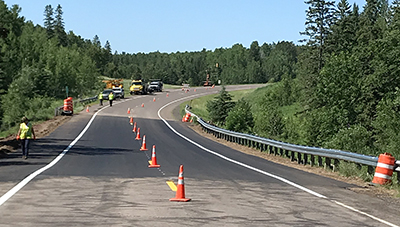
Hwy 23 reopened July 6 after crews made temporary repairs to the road that received heavy damage due to flooding on June 17. Temporary repairs include new pavement and guardrail. District 1 will make permanent repairs to the highway in conjunction with other projects underway next summer to minimize disruption to motorists. Photo by Roger Kachelmeyer |
More than a dozen sections of state highways, as well as several local roads, felt the effects of relentless rains during the past few weeks.
Hardest hit were highways in southwest and southcentral Minnesota, which kept MnDOT maintenance crews in Districts 7 and 8 busy, including closing roads, setting up detours, constructing a temporary levee, installing floodwalls, clearing mudslides, restoring slopes and repairing a sinkhole.
“As of this morning (July 11), water is receding in all areas, although very slowly in some spots,” according to Jed Falgren, District 7 assistant district engineer for Maintenance Operations. He said crews are monitoring scour and inspecting for debris at some bridges, but have not found any significant concerns.
In District 1, MnDOT reopened Hwy 23 at the south fork of the Nemadji River July 6, according to Beth Petrowske, District 1 public affairs coordinator. The road had been closed since June 17 due to flooding. Crews made temporary repairs to the highway, which included pavement surfacing and guardrail installation.
“Plans are to make permanent repairs next summer in conjunction with two other planned projects on Hwy 23. Doing all of the work at one time will minimize the time we need to close Hwy 23 and use the detour,” she said.
Some of the many challenges District 7 crews have faced recently include clearing a mudslide that occurred July 1 on Hwy 68 southeast of New Ulm. This video shows the roadway after the mudslide and after crews stabilized the slope that collapsed because of heavy rain and high water levels in the area. The highway reopened to traffic July 6. Photos by District 7; drone footage courtesy of Office of Land Management |
|
 |
|

|
 |
TABLE of CONTENTS
 |
Successful collaboration restores Grand Portage Reservation River |
By Beth Petrowske, District 1 public affairs coordinator
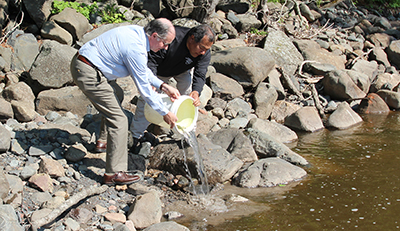
Commissioner Charlie Zelle (left) and Norman Deschampe, Grand Portage Band of the Chippewa Tribal chairman; release trout into the Reservation River June 18. Photo by Beth Petrowske |
Commissioner Charlie Zelle and Norman Deschampe, Grand Portage Band of the Chippewa Tribal chairman, poured a bucket of lively trout fingerlings into the Reservation River June 18 to celebrate the completion of a successful river restoration project.
The trout release was the culmination of two years of collaborative work to address an ongoing erosion issue at Reservation River.
Flood damages the site
The flood caused severe erosion to a 500-foot-long section of the river on the west side of Hwy 61. After the flood, gabion baskets (steel mesh cages) filled with rock were installed along the banks to prevent further erosion. Over the ensuing decades, some of the gabion baskets fell into the river. This eliminated the erosion protection they had provided. They also presented a hazard to wildlife and people, and interrupted the stream flow.
Collaboration begins
“District staff meet with the Grand Portage Band of the Chippewa annually to discuss projects,” said Duane Hill, District 1 engineer. “The need to address the ongoing erosion issue was discussed. This was the beginning of the collaborative effort to construct a natural stream channel, which enhances fish habitat and addresses the concern of erosion.”
“Hwy 61 is the only transportation corridor that links Grand Portage to the rest of the state,” added Hill. “Protecting it from potential road washouts is critically important.”
Dave Mohar, District 1 hydraulics engineer, began assembling a group that included tribal representatives and other stakeholders. During the design phase of project development, the group met to work through a variety of concerns and logistical issues. The suggestion by Mohar for a natural stream design was supported by the group. The Grand Portage Band of the Chippewa provided review and input on the proposed stream design and materials incorporated in the repair. They also supplied all of the toe-wood used on the project. Toe-wood is woody material and for this project large tree roots were used. It was buried in the river banks to replicate natural streambanks.
Restoration
Project staff used surveying, river geomorphology and a study of historic conditions to develop a natural channel design that would stabilize the river. The design included a floodplain bench, riffle structures, toe-wood and native plantings to provide for a natural, fish-passible design. The river was diverted around the work area during restoration.
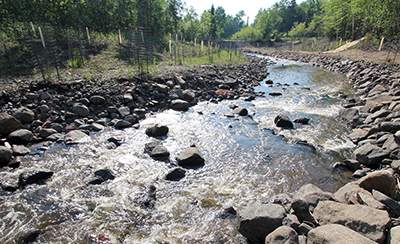
The Reservation River is located in the far northeast corner of the state, near the Canadian border. It flows from Swamp Lake on the western edge of the Grand Portage Indian Reservation south 6.9 miles to Lake Superior. The restored section of the river is visible from Hwy 61. Photo by Beth Petrowske |
The restoration project began with the removal of the gabion baskets. The baskets probably seemed like a good choice for erosion control in the 1970s, but today there are materials and methods available to stabilize and re-contour rivers in a much more natural-looking way.
The restoration project began in August 2017 and was substantially complete by mid-September. Federal, tribal, state and county staff worked together to restore the river, ensuring long-term benefits to the community and ecology. Final punch-list items were completed early this summer. MnDOT provided $167,000 for construction costs and an additional $65,000 for engineering, design and project management.
The finished project was designed using natural alternatives that consider native plant species, fish habitat and river hydrology to re-contour the stream. The goal was to mitigate future damage from floods, provide safer access and provide a perfect, sediment-free habitat for trout, including the newest trout inhabitants released June 18.
Project partners included the Grand Portage Band of the Chippewa, Cook County Soil and Water Conservation District, MnDOT, the U.S. Army Corps of Engineers, and Laboda Grading. |
 |
|

|
 |
TABLE of CONTENTS
 |
Hwy 1/169 Eagles Nest project is complete, open for traffic |
|
By Stephanie Christensen, District 1 public affairs coordinator
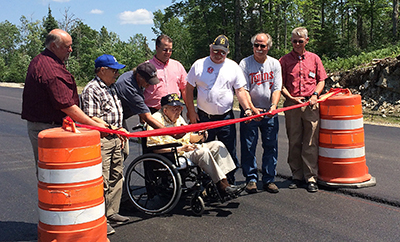
(Right) Duane Hill, District 1 engineer joins local leaders June 21 for a ribbon cutting ceremony for the Hwy 1/169 Eagles Nest reconstruction project. Photo by Karen Bohjanen |
A ribbon-cutting ceremony was held June 21 to celebrate the completion of the Hwy 1/169 Eagles Nest reconstruction project in Ely. Approximately 60 people attended the event, which included speeches given on behalf of congressional leadership, MnDOT, local city council, the Hwy 169 Task Force, and the local community.
Many speakers reflected on the road's history and thanked everyone involved in the completion of the project.
“After many years of grass-roots effort, public meetings, plan development and environmental challenges, we can all be proud, that together, we have reached this point,” said Duane Hill, District 1 engineer. “The Hwy 169 Task Force deserves a great deal of credit for the hundreds - perhaps thousands of hours they put into this project since 1999.”
Originally the Hwy 1/169 corridor was identified as having several transportation deficiencies which contributed to higher than average crash ratings for the area. In 1999 the Hwy 169 Task Force was formed to address safety concerns. MnDOT began working with the task force in 2005 to develop design alternatives that would improve safety. However, there were many potential environmental impacts and several hurdles to overcome before reaching the project’s completion.
One of the biggest challenges was the areas sulfide baring rock. Working with several agencies, such as the Environmental Protection Agency, Army Corps of Engineers, and the Department of National Resources, a technical working group was formed to help develop a rock mitigation plan. In summer 2012, MnDOT initiated the development of a new design using recently developed performance-based standards. In addition to addressing the sulfide baring rock, this plan also took noise, costs, property impact and passing opportunities into account. After many years of project preparation, work finally began in 2017.
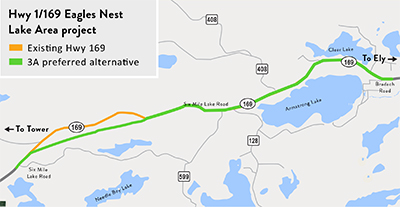
The Hwy 169 Eagles Nest project opened to motorists June 26. |
The new 5.7 mile-long section of highway balances social, economic and environmental impacts. Project benefits include improved sight lines, safer pull-off areas, improved drainage and a minimal effect to wetlands. Additionally the new alignment reduces shading, which previously contributed to icy road conditions, and improves safety with wider shoulders and increased passing opportunities.
The ribbon was officially cut by founding task force member, Pete Davis. The road officially opened to traffic June 26. More information on the $16.3 million project can be found on the project website. |
 |
|

|
 |
TABLE of CONTENTS
 |
Incidents show need for motorists to pay attention to road closed signs |
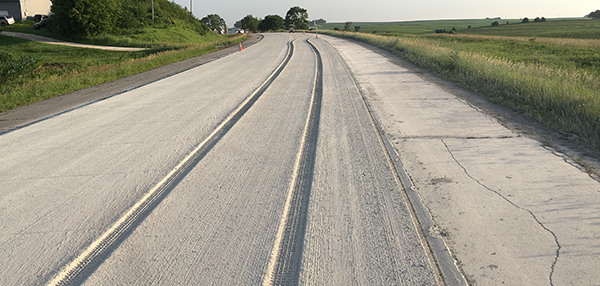
Two incidents on construction projects emphasize the importance for motorists to pay attention to road closures. (Above) A motorist drove on fresh concrete July 1 on Hwy 63 near Zumbrota. The motorist drove about 800 feet into the fresh concrete. Crews had to take out the damaged section and replace it with new concrete, which cost more than $100,000. The incident reminds motorists not to drive around barricades and cones. If a motorist causes damage to a construction project, they can be ticketed and face an insurance claim. Photo by Brad Horn, District 6 construction (Below) A motorist enters a restricted area on the ramp from 31st Street to I-35W south in Minneapolis. The ramps are closed to regular traffic to provide a transit advantage to buses that can carry more people than a single-passenger vehicle. So many cars are passing through the ramps during rush hour that buses are being slowed down and their routes are behind. Photo by Aaron Tag, Metro District west area engineer
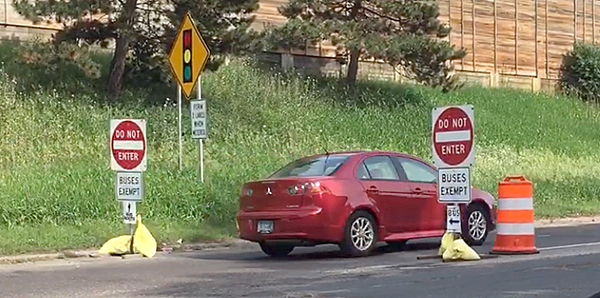
|
|
 |
|

|
 |
TABLE of CONTENTS
 |
Agency makes organizational changes |
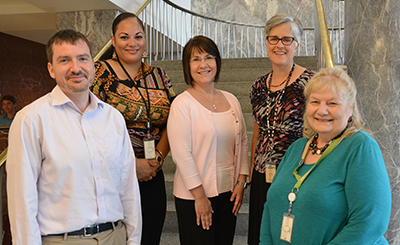
Staff in the new Office of Organizational Planning and Management include (from left) Brian McLafferty, Toreen Cordova, Judy Schmidt, director, Susan Walto and Judy Jacobs. Photo by Rich Kemp |
Effective July 2, MnDOT will have a new Office of Organizational Planning and Management to lead the agency’s business planning effort and support the implementation of the Strategic Operating Plan, a critical piece of how MnDOT will manage its operating budget during the next five years. Staff includes the former Resource Management Team members.
Judy Schmidt will lead the new office, which reports to Kristi Schroedl, chief financial officer. Other staff members are Toreen Cordova, Judy Jacobs, Brian McLafferty and Susan Walto. The group is located in the Central Office in St. Paul, Room G-18.
“Because implementing the SOP involves a shift in MnDOT’s approach to organizational planning and management and will take a tremendous amount of agency effort, there will be no separate effort called WIG 3.0,” said Sue Mulvihill, deputy commissioner and chief engineer. “The implementation of the SOP will be MnDOT’s next wildly important and ongoing focus.”
WIG Team members Jocelyn Stein, AnneMarie Burgess and Nancy Bennett will move to the Office of Administration under the direction of Suzie Thayer. The WIG Team expertise, previously part of the Chief of Staff’s section, will support the work of the Office of Administration and its mission to provide administrative leadership, service and support to the offices and districts. As the current WIG 2.0 effort wraps up, staff transitions will occur gradually during July and August. (See separate article in this issue for WIG 2.0 update.) |
 |
|

|
 |
TABLE of CONTENTS
 |
Nominations sought for final round of WIG 2.0 Shout Out recognition |
By Judy Jacobs
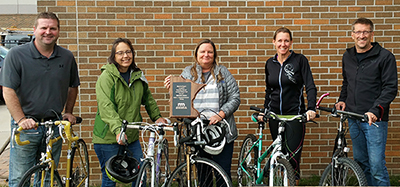
Shout Out! Round 1 winners from District 4, Shiloh Wahl, Mary Safgren, Jane Butzer, Tori Nill and Milt Wilson, pose with their recognition plaque. Photo by Jeremiah Moerke |
The WIG 2.0 “Shout Out” recognition friendly competition is here for a third and final round.
The process for the final round will be similar to Rounds 1 and 2. All sub-WIGs that have either been completed, or reached key milestones, are eligible to enter. All results must be entered in the SharePoint sub-WIG tracker no later than July 31.
WIG coaches are being asked to submit their list of Shout Out! nominations to the WIG Team by Aug. 8. The nominee lists from nearly 70 WIG coaches across the state will be compiled for review by the WIG 2.0 champions.
WIG champions and MnDOT leadership will review and select the winning teams to recognize the teams that have achieved success with their sub-WIGs.
All sub-WIGs with reported results that have not been recognized in Rounds 1 and 2 are eligible to enter this final round of shout out. If teams have work to continue beyond Aug. 1, they should report what they have achieved to date, and their action plan for how to return work into the whirlwind.
“The purpose of the Shout Out! Final Round of recognition is to thank and recognize employees for their hard work and efforts with WIG 2.0,” said Sue Mulvihill, deputy commissioner, chief engineer and champion for WIG 2.0. “This is an important way to raise the visibility of WIG results, employee innovation and success stories.”
Work with your coach to get your results updated in SharePoint. Your team could be the next to be spotlighted for recognition!
A survey focused on the Improving Intentional Customer Engagement priority of WIG 2.0 will be arriving in employee mailboxes in a couple weeks. Itís designed to measure the impact of MnDOTís efforts to improve customer involvement, impact and experience. Use your last weekly commitment of WIG 2.0 to complete the survey (which is expected to take 2 Ė 4 minutes).
An external partner survey is also planned for August. Results are anticipated to be released in late 2018. |
|
 |
|

|
 |
TABLE of CONTENTS
 |
New services available for employee injuries |
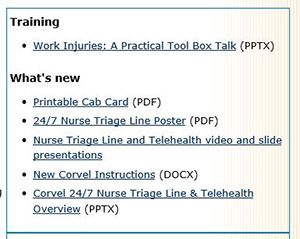
Resources can be found under the Whatís New area of the Work Injury website. |
There will be new services available beginning July 16 for employees who are injured while on the job. The state of Minnesota uses Corvel, which provides medical case management for injured workers. The contract with Corvel was renewed to provide supplemental services, which includes a 24/7 Nurse Triage line and Telehealth.
If it is an emergency, call 911. For non-emergency injuries, employees must contact their supervisor immediately after a work injury. All employees with a non-emergency work injury must call the 24/7 Nurse Triage Line at 1-844-235-2055, and a nurse will provide medical triage services, including first aid.
If it is determined that medical treatment is needed after calling the Nurse Triage Line, employees may be referred to the Telehealth medical provider. Telehealth is an optional service an employee can choose to participate in and provides a virtual medical visit option 24 hours a day using any device that will connect to the internet. An employee may connect from home or work with a computer, cell phone, or iPad. Employees can receive on-the-spot care.
Watch for the new 24/7 Nurse Triage Line posters to be placed on bulletin boards and work areas.
To learn more, there is a pre-recorded video session posted for employees and supervisors to access on the MnDOT Work Injury Website under the What’s New area, as well as links to other helpful materials and videos.
Employees may contact the local Workers’ Compensation Coordinator with questions. Contact information can be found at http://ihub/d1/safety/workinjuries.html. |
 |
|

|
 |
TABLE of CONTENTS
 |
Employees help reduce shared drive space; Civil Rights office takes top honors |
By Charles Stech, Office of Chief Counsel
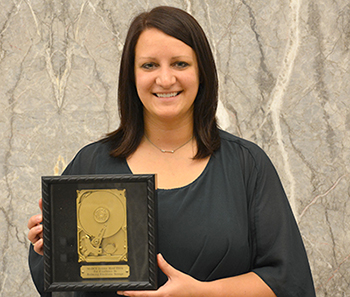
Amy Sullivan, Office of Civil Rights, holds the Golden Hard Drive. Her office won the traveling trophy in June during the spring data storage clean-up month. Photo by Rich Kemp |
The winner of this year’s shared drive reduction initiative is the Office of Civil Rights. The office reduced its shared drive by 27.34 percent, the highest percentage of reduction in June. District 6 was the largest reducer in the districts with 13.06 percent. Honorable mention goes to the Office of Land Management, which deleted more than 400,000 files that were no longer needed.
“Thank you to everyone who helped out in our effort to reduce the excessive amount of electronic files,” said Jennifer W. Witt, records and information manager. “These efforts will help with increased storage space and reduce cost.”
Amy Sullivan, Office of Civil Rights, said her office has been striving towards better data retention with the goal of having an identified location to store each document throughout its life cycle.
“Our office took this opportunity to spend some time identifying duplicative and outdated files and eliminating them,” said Sullivan. “Each employee took a little time out of their week to reduce the office's storage footprint. We are proud to receive this award and will continue our efforts in achieving efficiency in data storage and retention.”
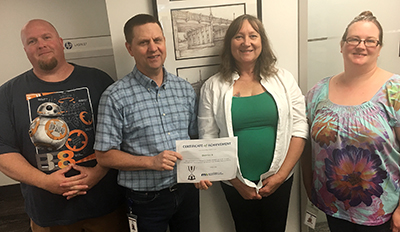
District 6 leaders who helped the district reduce more than 326 GB of data from shared drives are (from left) Steve Miller, structures; Keith Kallin, surveys (also MAT); Kathy Bartz, Rochester construction, and Autumn Wright, administrative support. Photo by Anne Meyer |
District 6 was close to its storage limit when the Management Action Team took on the task of helping departments reduce data. Tom Riordan, MNIT, and Keith Kallin, District 6 MAT, sat down with each section to explain the problem, provide parameters and offer practical advice on how to handle and think about data storage differently.
The one-on-one effort worked. During the file share clean up in May, District 6 reduced its data storage by more than 326 GB.
“It took a group effort to accomplish that success and now the goal is to keep the momentum going by encouraging departments to keep applying those principles,” said Kallin. “We still have a ways to go, but it is good to see our people adopting a different mindset about data storage, file redirection and making the effort to reduce.”
Employees were asked to dedicate four hours during May to review their office’s shared drive and delete outdated redundant, obsolete, trivial or ROT electronic files that reached the end of their retention period.
Previous Golden Hard Drive winners were:
- Office of Communications - Spring 2016
- Office of Civil Rights - Fall 2016
- Office of Freight and Commercial Vehicles - Spring 2017
- Office of Environmental Stewardship - Fall 2017
Up next on the clean-up front: “December of Destruction.” During the entire month of December, MnDOT will delete ROT email. |
 |
|

|
 |
TABLE of CONTENTS
 |
Star of the North program serves as a pipeline for future MnDOT employees |
By Rich Kemp

Kirsten Henry, Technology Investment Management, completed the Star of the North Fellowship program and was recognized during a ceremony June 29. Photo courtesy of the Minnesota Management and Budget |
MnDOT had three fellows participate in the recent Star of the North fellows program. Several state agencies participated in the program that offers a 12-month salaried position.
Participating for MnDOT were:
- Brenda Rivera, Office of Business Administration
- Kirsten Renee Henry, Technology Investment Management
- Lawrence Karongo, Office of Equity and Diversity
“As one of the largest employers in Minnesota, it is critical for state government to recruit bright, innovative talent into state service,” said Minnesota Management and Budget Deputy Commissioner Edwin Hudson. “The fellowship program enables us to find and prepare the future leaders of state government, people with exciting ideas who are passionate about serving their communities.”

A ceremony was held at the Veteran Services Building in St. Paul for the Star of the North program. Participating in the event were (from left) Liz Harens, Technology Investment Management and 2015 fellow; Kirsten Henry, Technology Investment Management; Lawrence Karongo, Office of Equity and Diversity; and Brenda Rivera, Office of Business Administration. Photo courtesy of the Minnesota Management and Budget |
This is the fourth cohort to be brought into state service through the Star of the North fellowship program. To be considered for a fellowship, applicants must demonstrate an interest in a career in public service and have, or be in process of obtaining, an advanced degree. Fellows are placed at an agency that best fits their education for year-long, salaried positions.
“When I first started, I kept hearing that MnDOT is like a family and people take care of each other here,” said Rivera. “I learned that first hand when a fellow co-worker needed help during the holidays and MnDOT employees came together to help them out in a time of need. I knew at that point that I made the right decision to come here to work and take a leap of faith by leaving the private sector. I have learned so much in the last year.”
The Star of the North Fellowship program is also a critical piece in the state’s effort to increase diversity and address an aging workforce. The Star of the North program serves as a pipeline for hiring the fellows into full-time positions once the program ends. Of the 14 fellows who took part in the 2016-17 cohort, 11 were hired into permanent positions with the state, two enrolled in full-time doctoral programs, and one found employment with the federal government.
While participating in the program, Rivera was hired as an assistant ombudsman in the Public Engagement and Constituent Services Office.
For more information on future fellowship opportunities with the state of Minnesota, visit the MN Careers website. |
 |
|

|
 |
TABLE of CONTENTS
 |
Meet Greta, summer maintenance worker |
|
This video is part of a series of MnDOT maintenance worker video profiles. Greta Utech is a summer laborer at the Lakeville truck station. Video produced by Rich Kemp |
|
 |
|

|
 |
TABLE of CONTENTS
 |
Employees volunteer at Second Harvest Heartland |
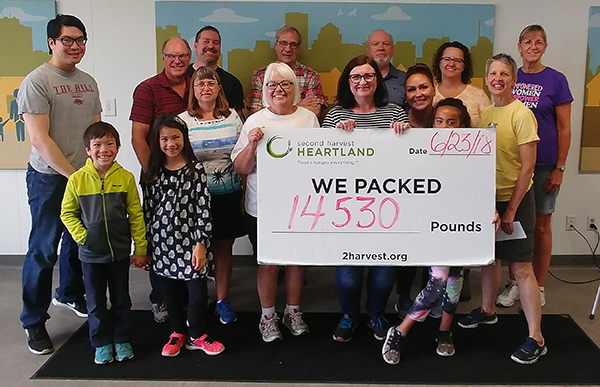
The Office of Land Management initiated an effort in which 17 people volunteered at Second Harvest Heartland June 23. Employees and family members packed over 14,500 lbs. of apples and potatoes. Photo courtesy of the Office of Land Management |
|
 |
|
| |
|



